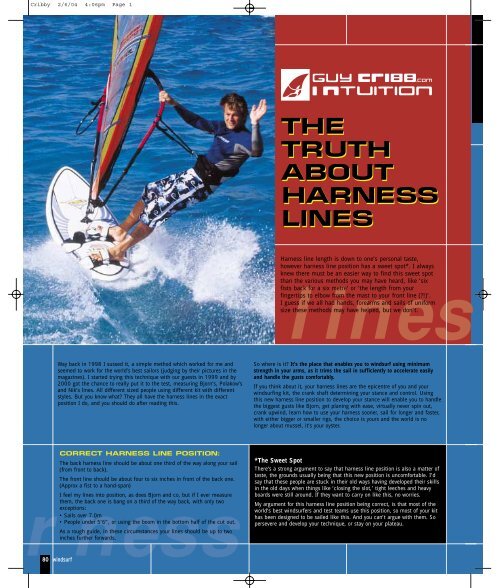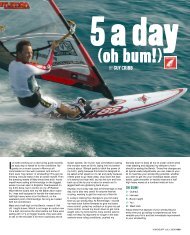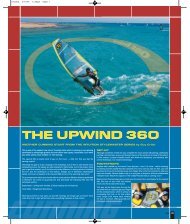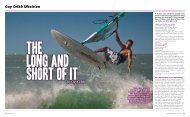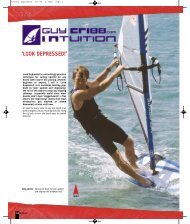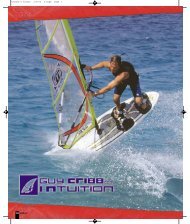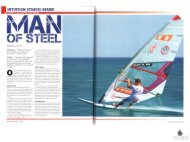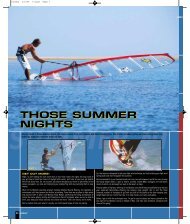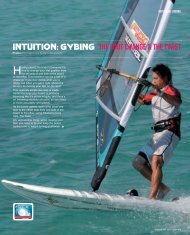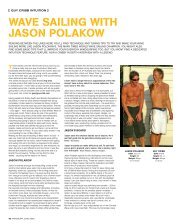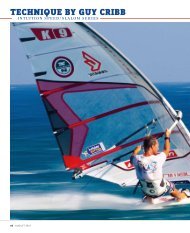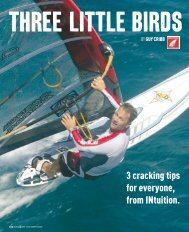the truth about harness lines the truth about harness lines - Guy Cribb
the truth about harness lines the truth about harness lines - Guy Cribb
the truth about harness lines the truth about harness lines - Guy Cribb
You also want an ePaper? Increase the reach of your titles
YUMPU automatically turns print PDFs into web optimized ePapers that Google loves.
<strong>Cribb</strong>y 2/6/04 4:06pm Page 1<br />
THE<br />
TRUTH<br />
ABOUT<br />
HARNESS<br />
LINES<br />
Harness line length is down to one’s personal taste,<br />
however <strong>harness</strong> line position has a sweet spot*. I always<br />
knew <strong>the</strong>re must be an easier way to find this sweet spot<br />
than <strong>the</strong> various methods you may have heard, like ‘six<br />
fists<br />
<strong>lines</strong><br />
back for a six metre’ or ‘<strong>the</strong> length from your<br />
fingertips to elbow from <strong>the</strong> mast to your front (?!)’.<br />
I guess if we all had hands, forearms and sails of uniform<br />
size <strong>the</strong>se methods may have helped, but we don’t.<br />
Way back in 1998 I sussed it, a simple method which worked for me and<br />
seemed to work for <strong>the</strong> world’s best sailors (judging by <strong>the</strong>ir pictures in <strong>the</strong><br />
magazines). I started trying this technique with our guests in 1999 and by<br />
2000 got <strong>the</strong> chance to really put it to <strong>the</strong> test, measuring Bjorn’s, Polakow’s<br />
and Nik’s <strong>lines</strong>. All different sized people using different kit with different<br />
styles. But you know what? They all have <strong>the</strong> <strong>harness</strong> <strong>lines</strong> in <strong>the</strong> exact<br />
position I do, and you should do after reading this.<br />
So where is it? It’s <strong>the</strong> place that enables you to windsurf using minimum<br />
strength in your arms, as it trims <strong>the</strong> sail in sufficiently to accelerate easily<br />
and handle <strong>the</strong> gusts comfortably.<br />
If you think <strong>about</strong> it, your <strong>harness</strong> <strong>lines</strong> are <strong>the</strong> epicentre of you and your<br />
windsurfing kit, <strong>the</strong> crank shaft determining your stance and control. Using<br />
this new <strong>harness</strong> line position to develop your stance will enable you to handle<br />
<strong>the</strong> biggest gusts like Bjorn, get planing with ease, virtually never spin out,<br />
crank upwind, learn how to use your <strong>harness</strong> sooner, sail for longer and faster,<br />
with ei<strong>the</strong>r bigger or smaller rigs, <strong>the</strong> choice is yours and <strong>the</strong> world is no<br />
longer <strong>about</strong> mussel, it’s your oyster.<br />
CORRECT HARNESS LINE POSITION:<br />
The back <strong>harness</strong> line should be <strong>about</strong> one third of <strong>the</strong> way along your sail<br />
(from front to back).<br />
The front line should be <strong>about</strong> four to six inches in front of <strong>the</strong> back one.<br />
(Approx a fist to a hand-span)<br />
rness<br />
80 windsurf<br />
I feel my <strong>lines</strong> into position, as does Bjorn and co, but if I ever measure<br />
<strong>the</strong>m, <strong>the</strong> back one is bang on a third of <strong>the</strong> way back, with only two<br />
exceptions:<br />
• Sails over 7.0m<br />
• People under 5’6”, or using <strong>the</strong> boom in <strong>the</strong> bottom half of <strong>the</strong> cut out.<br />
As a rough guide, in <strong>the</strong>se circumstances your <strong>lines</strong> should be up to two<br />
inches fur<strong>the</strong>r forwards.<br />
*The Sweet Spot<br />
There’s a strong argument to say that <strong>harness</strong> line position is also a matter of<br />
taste, <strong>the</strong> grounds usually being that this new position is uncomfortable. I’d<br />
say that <strong>the</strong>se people are stuck in <strong>the</strong>ir old ways having developed <strong>the</strong>ir skills<br />
in <strong>the</strong> old days when things like ‘closing <strong>the</strong> slot,’ tight leeches and heavy<br />
boards were still around. If <strong>the</strong>y want to carry on like this, no worries.<br />
My argument for this <strong>harness</strong> line position being correct, is that most of <strong>the</strong><br />
world’s best windsurfers and test teams use this position, so most of your kit<br />
has been designed to be sailed like this. And you can’t argue with <strong>the</strong>m. So<br />
persevere and develop your technique, or stay on your plateau.
<strong>Cribb</strong>y 2/6/04 4:06pm Page 2<br />
STRETCH MARKS:<br />
I invented this product called ‘Stretch Marks,’ which for a moment I thought<br />
would make my millions, but as it’s only 50p of elastic, I didn’t pursue it any<br />
fur<strong>the</strong>r, short of showing my guests it on our courses. ‘Stretch Marks’ shows<br />
where your <strong>lines</strong> should be.<br />
STRETCH<br />
Buy a bit of elastic, approx 150cm and attach a hook to ei<strong>the</strong>r end (I’ve heard<br />
picture hooks are okay). Mark a position on it one third of <strong>the</strong> way along. As<br />
<strong>the</strong> elastic stretches to fit different sail sizes, <strong>the</strong> mark remains one third of<br />
<strong>the</strong> way along it. Like a painkiller, simple but effective. Noble Prize coming<br />
my way? Doubt it.<br />
FINDING THE ONE THIRD POSITION<br />
Position your rear <strong>harness</strong> line one third of that measurement (If using a tape<br />
measure, for instance on a 180cm sail width, position back <strong>harness</strong> line at<br />
60 cm from front of mast)<br />
Measure from <strong>the</strong> front of <strong>the</strong> rig...<br />
...to <strong>the</strong> clew of <strong>the</strong> sail, immediately alongside <strong>the</strong> boom.<br />
trutJan/Feb 81
<strong>Cribb</strong>y 2/6/04 4:06pm Page 3<br />
THE REASONS WHY THIS IS THE CORRECT POSITION.<br />
The correct <strong>harness</strong> line position naturally sheets in <strong>the</strong> sail enough to:<br />
✔<br />
If your <strong>harness</strong> <strong>lines</strong> are too far forwards:<br />
✖<br />
• Improve early planing and maintain control in <strong>the</strong> gusts, without using as<br />
much strength in your arms.<br />
• Tip <strong>the</strong> rig fur<strong>the</strong>r forwards <strong>the</strong>reby improving early planing and increasing<br />
Downforce, increasing control and upwind ability.<br />
• The sail is sheeted out, so you’d need serious muscle to pull it under<br />
control.<br />
• The sail is raked back, losing Downforce and power.<br />
HOW TO ADAPT YOUR STANCE.<br />
Some of you will find this <strong>harness</strong> line position great from <strong>the</strong> moment<br />
you try it, but most of you will need to develop your skills to get more<br />
comfortable. In my experience this new position will be fur<strong>the</strong>r back<br />
than you’re used to and your initial reaction will be;<br />
‘I LIKE IT IN THE GUSTS, BUT MOST OF THE TIME THERE’S TOO<br />
MUCH PULL ON MY FRONT HAND.’<br />
The two biggest tips to help you relieve your front hand of this extra pull<br />
are:<br />
Tip <strong>the</strong> rig forwards (opposite of ‘closing <strong>the</strong> slot’) transferring more power<br />
into <strong>harness</strong>.<br />
Let go with your back hand for as much time as possible (thus fur<strong>the</strong>r<br />
committing to your <strong>harness</strong>) (note: it should be very awkward to let go<br />
with your front hand)<br />
If <strong>the</strong>re’s still too much weight on your front hand, try moving your mast<br />
track back a bit, which will help to position <strong>the</strong> mast more upright.<br />
Whoever you are, your objective is always to have <strong>the</strong> power of <strong>the</strong> rig on<br />
your <strong>harness</strong> and not in your arms, so slouch into your <strong>harness</strong> and relax<br />
your grip.<br />
‘I FEEL LIKE I’M ON THE VERGE OF A CATAPULT THE WHOLE<br />
TIME!’<br />
Yup, right on <strong>the</strong> limit, using your kit to it’s fullest potential. OK, I<br />
recognise this is a stressy feeling and takes some getting used to. Anti<br />
catapult tips are;<br />
• more downhaul,<br />
• face where you are going,<br />
• don’t sheet in (provided your <strong>lines</strong> are in <strong>the</strong> right place),<br />
• have your back leg slightly more bent than your front one (unless going<br />
up wind).<br />
‘I KEEP FLYING OFF DOWNWIND!’<br />
Lean <strong>the</strong> mast quite radically towards <strong>the</strong> eye of <strong>the</strong> wind (instead of<br />
towards <strong>the</strong> nose of <strong>the</strong> board) and dig your heels in to turn <strong>the</strong> board<br />
upwind.<br />
WHY HAVE THE LINES SO CLOSE TOGETHER?<br />
Using <strong>the</strong> <strong>lines</strong> closer toge<strong>the</strong>r makes <strong>the</strong> rig more sensitive, so you get<br />
more feedback. That’s why all top level windsurfers never have <strong>the</strong>ir <strong>lines</strong><br />
fur<strong>the</strong>r apart than a small handspan.<br />
Some high level freestylers even have <strong>the</strong>ir <strong>lines</strong> almost touching<br />
eacho<strong>the</strong>r. This is because in competition <strong>the</strong>y rely so much on being able<br />
to get planing early, <strong>the</strong>y need as much information from <strong>the</strong> rig as possible.<br />
Plus, <strong>the</strong> very second <strong>the</strong>y get planing, <strong>the</strong>y need to know if <strong>the</strong>re<br />
enough power for <strong>the</strong>m to quickly jump. With <strong>the</strong>ir <strong>harness</strong> <strong>lines</strong> so close<br />
toge<strong>the</strong>r, all this information is literally at <strong>the</strong>ir finger tips.<br />
‘CLOSE THE SLOT - TRUE OR FALSE?’<br />
Closing <strong>the</strong> slot (raking <strong>the</strong> sail back to close <strong>the</strong> gap between <strong>the</strong> bottom<br />
of your sail and <strong>the</strong> board) is an expression born in <strong>the</strong> eighties. And<br />
that’s where it should have stayed. Unfortunately it still lingers and<br />
wrecks loads of windsurfers’ techniques! Do not ever consciously ‘close<br />
<strong>the</strong> slot’, it just kills <strong>the</strong> power and reduces Downforce. That’s not to say<br />
never close <strong>the</strong> slot, just never consciously do it. If you’re over powered<br />
on free ride or race kit, sometimes it happens naturally as you crouch<br />
down lower for control. But on freestyle or wave kit, never let it close!<br />
PERSEVERE!<br />
If you’ve been using <strong>the</strong> wrong <strong>harness</strong> line position for years, it’ll be a<br />
hard habit to break. The best way to develop is to persevere with this new<br />
technique, referring to <strong>the</strong>se tips after every few runs over a number of<br />
days, not minutes. However if your kit is older than 1997, badly tuned, or<br />
if your boom is in <strong>the</strong> bottom half of <strong>the</strong> cut-out, it’s likely you’ll need<br />
your <strong>lines</strong> <strong>about</strong> an inch fur<strong>the</strong>r forwards anyway.<br />
<strong>lines</strong><br />
82 windsurf
<strong>Cribb</strong>y 2/6/04 4:06pm Page 4<br />
BASIC HAND POSITIONS.<br />
Underpowered<br />
(front hand back, to make rig go forwards.)<br />
Cruising.<br />
Overpowered<br />
(wide grip for control.)<br />
UNHOOKING.<br />
With <strong>the</strong> <strong>lines</strong> fur<strong>the</strong>r back, <strong>the</strong>y’re easier to hook in and out of, which is<br />
good for wave sailors, freestylers, beginners and I guess, freeriders (that<br />
covers everyone doesn’t it?) Especially if you use this unhooking tip:<br />
1 2<br />
Use your existing unhooking skills (huge pelvic thrust etc) but also use<br />
your back thumb to push <strong>the</strong> <strong>lines</strong> out of <strong>the</strong> hook.<br />
THE FUTURE<br />
Over <strong>the</strong> next months I’m going to divulge some serious stance tips; The<br />
Missing Link (INtuition Core Skill), how to prevent spin-out, how to crank<br />
upwind, hang in <strong>the</strong>re at ninety miles and hour and accelerate with helium<br />
bones (Pulling Power). So watch this space!<br />
But if you can’t wait for a life changing experience, join us on one of our<br />
week long INtuition holidays, where we’ll turn you into superstar windsurfers<br />
with our ‘INtensive care’ program using our unique INtuition Core Skills and<br />
Muscle Memory.<br />
xxx 84 windsurf<br />
Our week long holidays are usually fully booked long in advance, so please<br />
sign up to our monthly ‘enewsletter’ where you can hear <strong>about</strong> our<br />
forthcoming courses first, all <strong>the</strong> latest news and a few technique tips. Send<br />
me an email to guy@guycribb.com, or for a copy of our brochure visit<br />
www.guycribb.com and go to ‘contact us.’<br />
future<br />
Please call <strong>Guy</strong> <strong>Cribb</strong> INtuition Holidays 01273 842 144 for more info.<br />
Our holidays are operated under <strong>the</strong> safety and guidance of<br />
Sportif ATOL 2910


